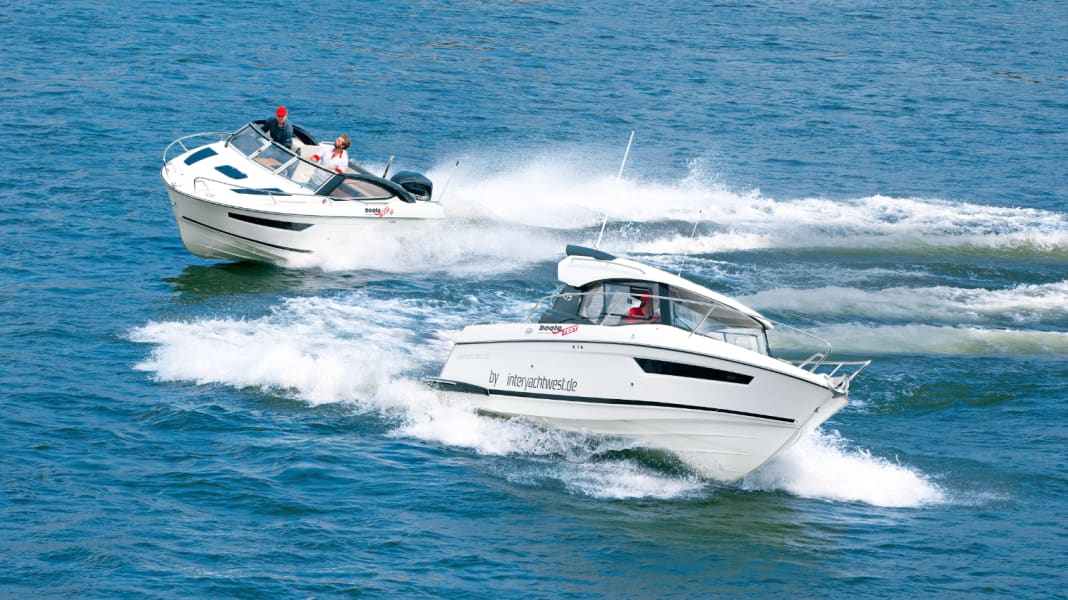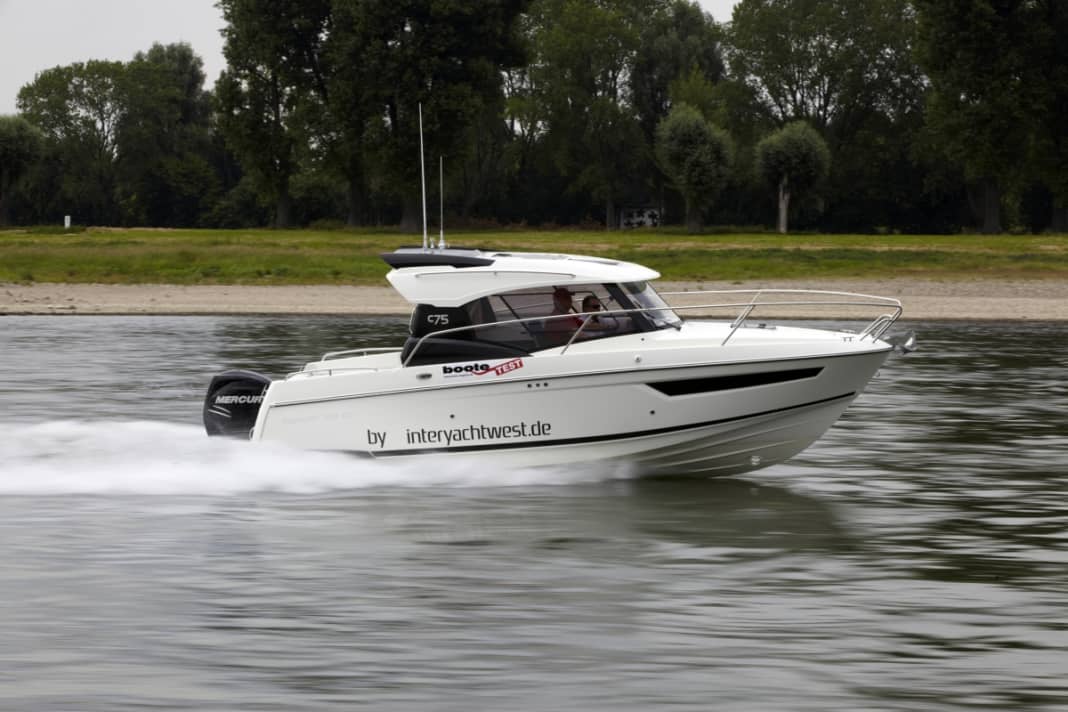






Although it is not new to use an underwater part and place various superstructures on it, it is simply clever. This way, the shipyard has less development work, simplifies work processes and, last but not least, saves money.
Our Parker 750 DC and CC test boats are built according to this principle. The abbreviation "DC" stands for the Daycruiser deck layout: a cabin cruiser with double berth, toilet room (extra) and huge cockpit with seating area and small cooking unit. The latter is located in front of the co-driver's seat and the single-burner hob can be pulled out of the glove compartment. A small sink is positioned above it and there is a refrigerator drawer under the passenger seat bench. The unit is perfectly adequate for preparing simple snacks, coffee and tinned meals. You can relax comfortably on the well-padded L-shaped bench. With the help of a folding backrest, the passenger seat can be integrated into the seating area in no time at all. If you then fold up the table, lower it and cover it with the additional cushion, you have a great sun lounger. A rear exit provides safe access to the bathing platform. You can climb in and out of the water with the help of a long folding pull-up ladder that is easy to operate from the water.
Cockpit on the CC not as comfortable as on the DC
Two aft passages to the split bathing platform (with ladder) can be found on the "CC" (Cabin Cruiser). Here, however, the cockpit is noticeably smaller and, with the two folding benches, not as comfortable as on the DC.
Instead, it has a so-called pilothouse, which protects the driver and crew from wind and weather. A roof hatch, opening side windows and the large rear door ensure open-air contact. In addition to the driver's cabin, there is also a seating area in the pilothouse, which is comfortable for two people. It is cramped for four, so it is more comfortable for two to sit on the starboard bench seat directly at the entrance.
There's just one catch: you can't make coffee at the same time because the pantry is hidden under the bench - which is actually a clever idea. The seating area can be converted into a bunk, which at 0.95 x 1.75 metres is too small for an adult couple, but is large enough for two children or one adult. There is more room to sleep in the bow: this double berth is big enough for two. However, you will look in vain for ventilation here, just like in the DC sister. Even if it is (only) about 6 cm, this extra dimension is clearly noticeable in the seat height. At 0.78 x 0.72 metres, the CC simply offers more comfort in the front cabin. On the other hand, DC guests enjoy more daylight thanks to two skylights in the cabin roof. The escape hatches on the foredecks are identical.
The motorisation of the Parker models
The same applies to the motorisation: our test duo is powered by identical 200 hp Mercury outboards (Verado). Different boat weights generally require adapted propeller dimensions. For our test candidates, this means: four-blade and 17" pitch for the heavier CC version and three-blade with 19" for the Daycruiser. However, the latter does not fit, as the maximum 5600 rpm at full throttle is simply too low for the engine. The manufacturer recommends 5800 rpm to 6400 rpm at full load.
Accordingly, the economic speed of 3500 rpm is also very low, which is particularly noticeable in comparison to the CC version, as it only reaches its cruising speed at around 5000 rpm. At 23 knots, the engine on the CC consumes 1.60 l/sm and the tank load is sufficient for 122 nm. At 19.5 kn, the DC can go much further at 178 nm, but this figure should be treated with caution due to the incorrect propeller.
The different set-ups and weights are also reflected in the acceleration phase, with the CC requiring around 300-500 rpm more for everything. According to the displays on the Cabin Cruiser, you can also raise the power trim a little more. Both hulls ride the choppy waters of the Rhine near Cologne smoothly, dryly and safely at a good 20 knots.
If you are making fast turns in calm water, you should not make them too tight with the drive down, as the boats start to rock. The DC is a little "tamer" than the CC. If the same action is trimmed, the propellers draw air (a little later on the DC), the hulls slow down, the propellers briefly regain power and the game starts all over again. The controls with sports steering wheels are impressive in this situation, as well as in slalom turns, thanks to their precision and ease of movement.
Manoeuvring with the Cabin Cruiser from Parker
A good rudder system is of course also important for manoeuvring in the harbour. Both impress in this respect with appropriate turning circles (1¼-1 ½) and direct manoeuvring behaviour. If you reverse too quickly, you risk getting your feet wet on the CC from 3000 rpm due to water sloshing in through the stern entrance.
When travelling slowly forwards, the seated DC rider has the window frame in their field of vision, which naturally improves with increasing speed due to the rising bow. The CC pilot has a completely unclouded view and, like his colleague in displacement mode, only has to correct the straight-ahead course from time to time.
Both drivers will find adjustable sports seats with comfortable upholstery and good lateral support. On the DC, the sun is partially reflected in the polished stainless steel instrument panel. Minus for both: We searched in vain for compasses. Plotters and the like are on the accessories list and can be easily integrated into the helm stations.
The route to the foredeck is different: the pilot house has a sufficiently wide side deck that can be reached via a step. The cabin roof, which is extended far outwards and aft, restricts freedom of movement.
Three steps at the centre passageway in the windscreen make it easier to climb aboard the sister boat. There are handrails on the foredeck above the windscreen frame, which you can use to shimmy up to the railing to find a new foothold. The standard electric and manual bilge pumps deserve special praise. The BOOTE standard for outboard boats is also met with a 2 kg fire extinguisher.
Fuses and main switch are located in easily accessible places. Parker installs a 108 Ah battery in the standard version. At the latest when an anchor winch or bow thruster comes on board, a second battery is also required for an additional charge. The technicians installed the cables and hoses professionally. This also applies for the most part to the boat's finish. However, there were one or two points of criticism on our test boats, such as loose side panelling or sharp-edged side windows. These are points that the dealer and shipyard have also recognised and want to improve on future boats.
Conclusion
The Parker 750 CC and DC are rock-solid models with good safety features apart from the missing compass. The DC has a sportier look and offers great open-air fun with its cockpit. In contrast, the carpool on the pilothouse is more sheltered and better suited to bad weather. With the 200 hp engines, the test duo is appealing on the road
Technical data
Model: Parker 750 CC
- Shipyard: Parker
- Type designation: Parker 750 CC
- CE category: C - Coastal waters
- Material of hull and deck: Plastic
- Length: 7,45 m
- Width: 2,55 m
- Displacement: 1,86 t
- Price: 65.685,00 €
Model: Parker 750 DC
- Shipyard: Parker
- Type designation: Parker 750 DC
- CE category: C - Coastal waters
- Material of hull and deck: Plastic
- Length: 7,45 m
- Width: 2,55 m
- Displacement: 1,75 t
- Price: 66.720,00 €

